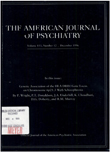Basal ganglia volumes and white matter hyperintensities in patients with bipolar disorder
Abstract
OBJECTIVE: Accumulating evidence suggests an association between abnormalities of the basal ganglia and affective disorders. The authors hypothesized that patients with bipolar disorder would demonstrate smaller basal ganglia volumes and a greater number of hyperintensities on magnetic resonance imaging than comparison subjects who were matched on age, race, sex, and education. METHOD: Volumes of the caudate, putamen, and globus pallidus were measured in 30 patients with bipolar disorder and 30 matched normal comparison subjects. The presence, number, and location of hyperintensities were also assessed. RESULTS: Male patients with bipolar disorder demonstrated larger caudate volumes than male comparison subjects. Older, but not younger, patients with bipolar disorder demonstrated more hyperintensities than comparison subjects, primarily in frontal lobe white matter. CONCLUSIONS: These results are not consistent with those of previous studies showing reduced basal ganglia volume in subjects with affective disorders, but they are consistent with previous findings of increased white matter hyperintensities, especially in older patients with bipolar disorder. Considered together with results from other studies, the findings suggest that the nature of basal ganglia/subcortical white matter involvement may differ according to the type of depression (unipolar versus bipolar) and the age and sex of the patient.
Access content
To read the fulltext, please use one of the options below to sign in or purchase access.- Personal login
- Institutional Login
- Sign in via OpenAthens
- Register for access
-
Please login/register if you wish to pair your device and check access availability.
Not a subscriber?
PsychiatryOnline subscription options offer access to the DSM-5 library, books, journals, CME, and patient resources. This all-in-one virtual library provides psychiatrists and mental health professionals with key resources for diagnosis, treatment, research, and professional development.
Need more help? PsychiatryOnline Customer Service may be reached by emailing [email protected] or by calling 800-368-5777 (in the U.S.) or 703-907-7322 (outside the U.S.).



